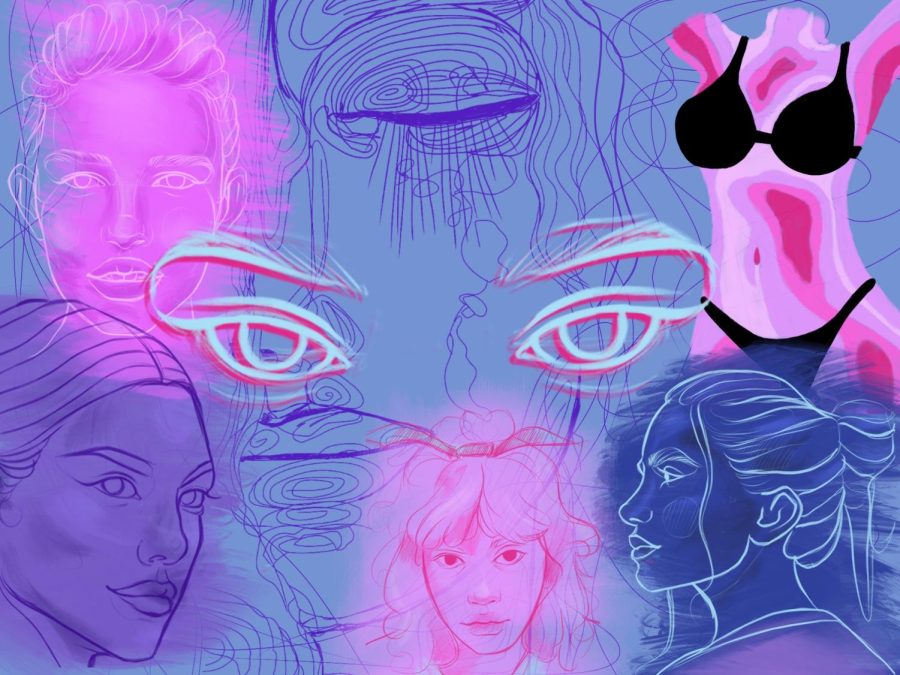Balls, Vogue, and Drag: A History of Queer Culture
The illustration represents the diverse and vibrant culture of drag.
With popular culture’s recent obsession with reality competition series RuPaul’s Drag Race, the topic of queer culture has come under the public eye with newfound interest. Full of lavish dresses and petty moments, many commend RuPaul for bringing a part of queer culture to the mainstream.
But queer culture, drag culture more specifically, is a lot more complex than gay men spending thousands of dollars on extravagant outfits while propagating manufactured drama. It is a dense history, packed with stories of rebellion, courage, and refuge.
The drag that we see in popular culture now is a departure from the cultural revolution that defined drag in the past. During its prime, it was used as a form of defiance, a way to break free from societal gender norms, to play with and redefine the concept of gender. And it wasn’t exclusive to cis people, like RuPaul’s Drag Race leads viewers to believe, either. In its original context, both trans and cisgender women and men alike would come alive on the stage, expressing themselves through dance, music, and clothing.
Though the concept of “cross-dressing” has existed for centuries (certainly, a man beingcast as Juliet in Shakespeare’s Romeo and Juliet puts the show’s sex jokes in a different light), the “cross-dressing” that characterises drag now was born during the late 19th century, where kings and queens would perform at bars in secrecy, when being queer and expressing yourself were both punishable offences.
And it wasn’t as white as history books like to claim. The Harlem Renaissance, a cultural revival of African American arts and academics, played a major role in the development of drag, and other parts of queer, culture. The revolutionary movement offered a new language that challenged social norms and demonstrated the fluidity of identity, showing Harlem, and by extension the world, the evolving nature of gender, sex, expression, and sexuality.
But despite the Harlem Renaissance and black kings and queens’ role in the development of drag, the segregation imposed by white queers during events (in which black performers would only be allowed on stage if they whitened their faces with makeup) would characterize the early age of drag. This would later culminate into the birth of another well-known facet of queer culture: ballrooms and voguing.
As Harlem continued to be a vibrant scene of queer culture and activism, drag slowly transformed from elegant pagaent competition to the exciting battles in the underground ballroom scene – both between the outfits of the contestants, and highly stylized dances which were named after a popular fashion magazine – Vogue. As an exhibit of expression of 1’s self and identity, vogue took from poses seen on the runway as well as ancient Egyptian art, utilizing exaggerated hand gestures and movements to tell stories to their audience.
These performances were well known and well-loved. The first documented drag ball was in 1867, where thousands of black queer folk dressed up in extravagant, personalized outfits, competing for awards, such as best dress or best impersonator. An 1886 article in the black newspaper The New York Freeman called that year’s ball the “event of the season.”
Just as the drag scene changed, so, too, did voguing. With time, dancers moved away from “Old Way,” a style that emphasized straight lines and harsh angles, to the “New Way”’ of the 1980s, which added elements that we see in popular culture to this day, such as the catwalk, the duckwalk, and spinning. Today, the “New Way” is characterized by more rigid movements and joint contortions, and the more popular style that we see in popular television shows (like RuPaul) uses what’s known as Vogue Fem, which focuses on speed, stunts, and flow.
For decades, the Bay Area has existed as a queer haven for young and old individuals alike. San Francisco, for example, is home to the Castro District, a neighborhood that LGBT veterans (dishonorably discharged for their sexuality) transformed. The Castro District would later be known as the “Gay Mecca” and would have many famous residents, such as the openly gay politician, Harvey Milk.
San Francisco also houses Compton’s Cafeteria, a diner that became a safe haven for trangender people – particularly trans women – starting from 1940 and reaching all the way to the 1970s. In August of 1966, 3 years before the infamous Stonewall Riots, a police officer harassed and attempted to arrest a transgender woman. She responded by throwing coffee in his face, and the people responded by inciting a riot that historian Susan Stryker calls “the 1st known incident of collective militant queer resistance to police harrassment in U.S. history.”
The vogue style of San Francisco reflects its legacy as a center of LGBT life and resistance. Equal parts harsh edges and soft curves, the dancing highlights acceptance in community, instead of existing as 1 concrete style. In the modern age of vogue, there is less of a focus on 1 set dance style; focusing on the joy of dancing and lack of rejection, instead.
Voguing, ballroom, and drag have all come a long way from their original moments of silent forms of rebellion and queer expression. Today, “drag” can involve dressing in extravagant outfits, wearing extreme makeup looks, simply crossdressing, or acting on stage as a fictional character.
But no matter what, it will always have its roots in black queer culture.
Your donation will support the student journalists of Campolindo High School's The Claw. Your contribution will allow us to produce more issues and cover our annual website hosting costs.

Senior V Rogers has had a passion for literature since they were young: “My bedtime stories were Baldwin and Angela Davis.” They have taken AP language...

Senior Grace Kelly’s passion for film led her to join The Claw art department. Kelly said, “Since I like making documentaries, journalism will definitely...



dent • Feb 5, 2025 at 7:36 pm
Do you have a source for the first harlem drag ball happening in 1867? Sorry if this seems at all pedantic but I’m currently trying to research early drag culture and I’ve seen 1867 and 1869 both be claimed without any real evidence.